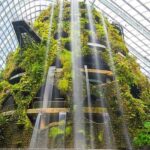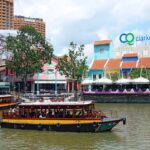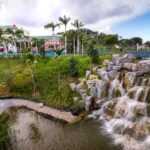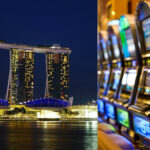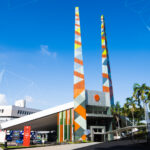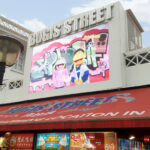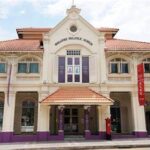
Singapore officially the Republic of Singapore, is a sovereign island city-state in maritime Southeast Asia. It lies about one degree of latitude (137 kilometres or 85 miles) north of the equator, off the southern tip of the Malay Peninsula, bordering the Straits of Malacca to the west, the Riau Islands (Indonesia) to the south, and the South China Sea to the east.
The country’s territory is composed of one main island, 63 satellite islands and islets, and one outlying islet, the combined area of which has increased by 25% since the country’s independence as a result of extensive land reclamation projects. It has the third greatest population density in the world. With a multicultural population and recognising the need to respect cultural identities, Singapore has four official languages; English, Malay, Mandarin, and Tamil. English is the lingua franca. Multiracialism is enshrined in the constitution and continues to shape national policies in education, housing, and politics.
Modern Singapore was founded in 1819 by Sir Stamford Raffles as a trading post of the British Empire. In 1867, the colonies in Southeast Asia were reorganised and Singapore came under the direct control of Britain as part of the Straits Settlements. During the Second World War, Singapore was occupied by Japan in 1942, and returned to British control as a separate crown colony following Japan’s surrender in 1945. Singapore gained self-governance in 1959 and in 1963 became part of the new federation of Malaysia,alongside Malaya, North Borneo, and Sarawak. Ideological differences led to Singapore being expelled from the federation two years later and it became an independent country. (Source from Wikipedia)

SINGAPORE
After early years of turbulence and despite lacking natural resources and a hinterland, the nation rapidly developed to become one of the Four Asian Tigers based on external trade, becoming a highly developed country; it is ranked ninth on the UN Human Development Index and has the second-highest GDP per capita (PPP) in the world. Singapore is the only country in Asia with a AAA sovereign rating from all major rating agencies. It is a major financial and shipping hub, has consistently ranked the most expensive city to live in since 2013, and has been identified as a tax haven. Singapore is placed highly in key social indicators: education, healthcare, quality of life, personal safety, and housing, with a home-ownership rate of 91 percent. Singaporeans enjoy one of the longest life expectancies, fastest Internet connection speeds, lowest infant mortality rates and lowest levels of corruption in the world.
The Flag of Singapore was adopted in 1959, the year Singapore became self-governing within the British Empire. It remained the national flag upon the country’s independence from Malaysia on 9 August 1965. The design is a horizontal bicolour of red above white, overlaid in the canton (upper-left quadrant) by a white crescent moon facing a pentagon of five small white five-pointed stars. The Singapore Arms and Flag and National Anthem Rules define the flag’s composition and the symbolism of its elements: red symbolises “universal brotherhood and equality of man”, and white symbolises “pervading and everlasting purity and virtue”. The waxing crescent moon represents a “young nation on the ascendant”. The five stars stand for the nation’s ideals of “democracy, peace, progress, justice and equality”
Ancient SINGAPORE
In 1299, according to the Malay Annals, the Kingdom of Singapura was founded on the island by Sang Nila Utama. Although the historicity of the accounts as given in the Malay Annals is the subject of academic debates, it is nevertheless known from various documents that Singapore in the 14th century, then known as Temasek, was a trading port under the influence of both the Majapahit Empire and the Siamese kingdoms, and was a part of the Indosphere. These Indianised kingdoms were characterised by surprising resilience, political integrity and administrative stability. Historical sources also indicate that around the end of the 14th century, its ruler Parameswara was attacked by either the Majapahit or the Siamese, forcing him to move to Malacca where he founded the Sultanate of Malacca. Archaeological evidence suggests that the main settlement on Fort Canning was abandoned around this time, although a small trading settlement continued in Singapore for some time afterwards. In 1613, Portuguese raiders burned down the settlement, and the island faded into obscurity for the next two centuries. By then, Singapore was nominally part of the Johor Sultanate. The wider maritime region and much trade was under Dutch control for the following period after the Dutch conquest of Malacca.
Name of SINGAPORE
The arrival of the British in 1819 is regarded as the birth of modern Singapore, but the earliest use of the actual name Singapore is pretty murky, and likely to have started around the 17th century. There are many different forms and spellings of Temasek, Singapura, and Singapore found in the old maps today – it was probably only around the 19th century that Singapore was used as the standardised English name and spelling throughout the country and globally, and continues to be used today.
Listed in the Malay Annals or Sejarah Melayu, the story goes that a Sumatran Prince from Palembang named Sang Nila Utama was out hunting one day when he caught sight of a mysterious animal in the distance. Taking it as a sign of good fortune, he established a city in the place where that animal was spotted, which turned out to be Singapore.
It is said that Sang Nila Utama’s mysterious animal was a lion, which is how Singapore ended up being named the Lion City. Though factually speaking, it is quite unlikely lions ever lived in Singapore because this isn’t a typical habitat for lions. It is thought that Sang Nila Utama might have seen a tiger instead – these fierce beasts used to roam wild in Singapore and menace villagers, until the last one was shot and killed in 1930.

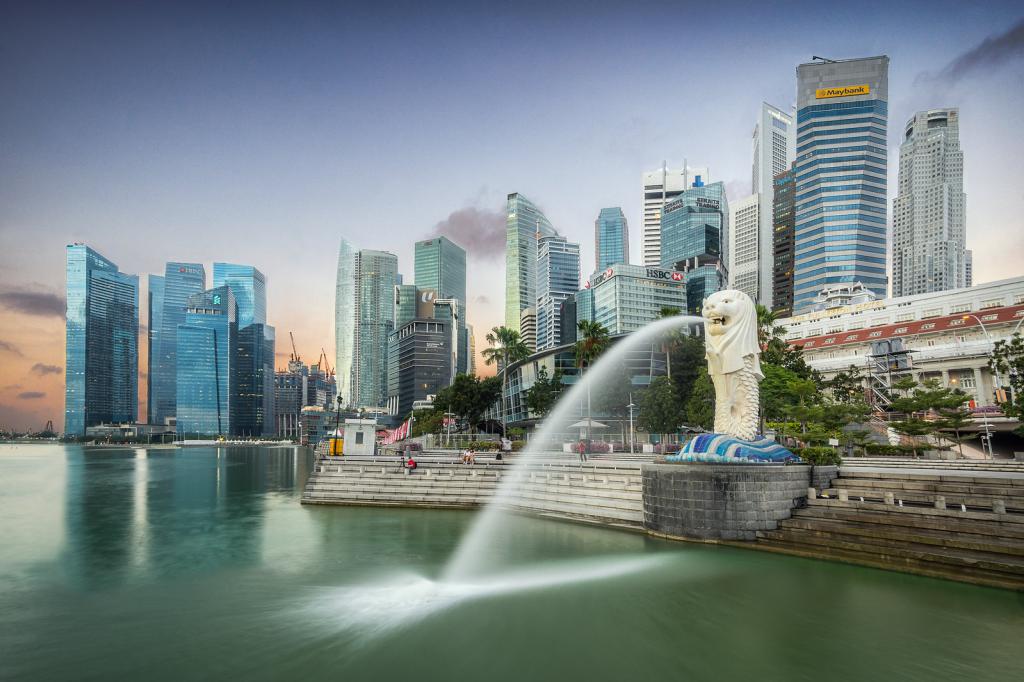
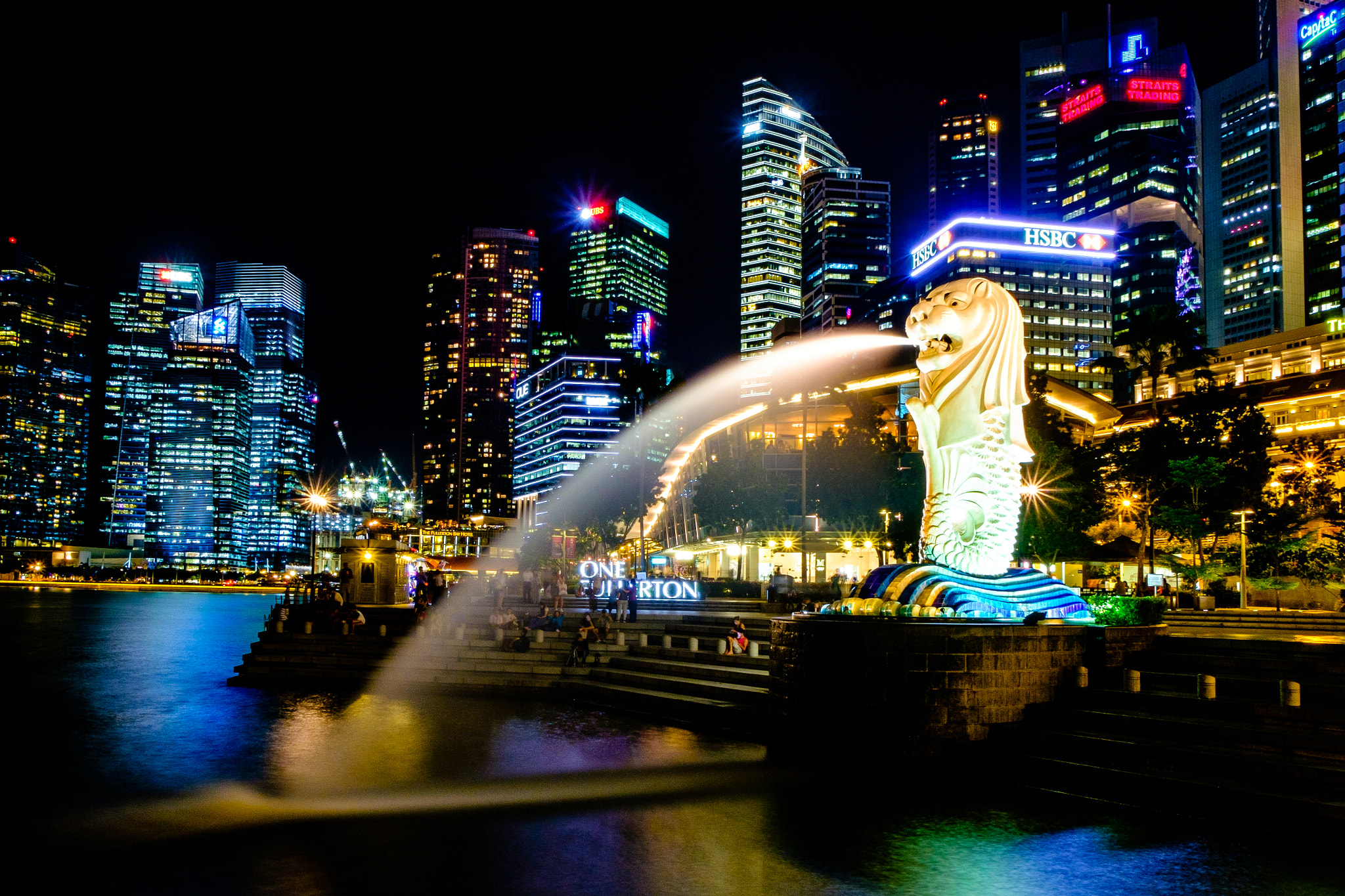
British colonisation
The British governor Stamford Raffles arrived in Singapore on 28 January 1819 and soon recognised the island as a natural choice for the new port. The island was then nominally ruled by Tengku Abdul Rahman, the Sultan of Johor, who was controlled by the Dutch and the Bugis. However, the Sultanate was weakened by factional division: Abdul Rahman, the Temenggong of Johor to Tengku Abdul Rahman, as well as his officials, were loyal to the Sultan’s elder brother Tengku Long, who was living in exile in Penyengat Island, Riau Islands. With the Temenggong’s help, Raffles managed to smuggle Tengku Long back into Singapore. Raffles offered to recognise Tengku Long as the rightful Sultan of Johor, under the title of Sultan Hussein, as well as provide him with a yearly payment of $5000 and another $3000 to the Temenggong; in return, Sultan Hussein would grant the British the right to establish a trading post on Singapore. A formal treaty was signed on 6 February 1819.








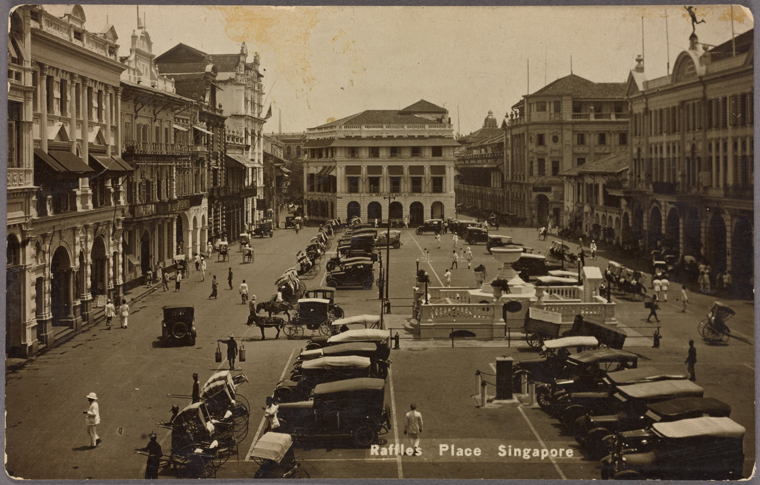
World War II
During the Pacific War, the Japanese invasion of Malaya culminated in the Battle of Singapore. When the British force of 60,000 troops surrendered on 15 February 1942, British prime minister Winston Churchill called the defeat “the worst disaster and largest capitulation in British history”. British and Empire losses during the fighting for Singapore were heavy, with a total of nearly 85,000 personnel captured. About 5,000 were killed or wounded, of which Australians made up the majority. Japanese casualties during the fighting in Singapore amounted to 1,714 killed and 3,378 wounded. The occupation was to become a major turning point in the histories of several nations, including those of Japan, Britain, and Singapore. Japanese newspapers triumphantly declared the victory as deciding the general situation of the war. Between 5,000 and 25,000 ethnic Chinese people were killed in the subsequent Sook Ching massacre. British forces had planned to liberate Singapore in 1945; however, the war ended before these operations could be carried out.








Within Malaysia
PAP leaders believed that Singapore’s future lay with Malaya, due to strong ties between the two. It was thought that reuniting with Malaya would benefit the economy by creating a common market, alleviating ongoing unemployment woes in Singapore. However, a sizeable pro-communist wing of the PAP was strongly opposed to the merger, fearing a loss of influence, and hence formed the Barisan Sosialis, splitting from the PAP. The ruling party of Malaya, United Malays National Organisation (UMNO), was staunchly anti-communist, and it was suspected UMNO would support the non-communist factions of PAP. UMNO, initially sceptical of the idea of a merger due to distrust of the PAP government and concern that the large ethnic Chinese population in Singapore would alter the racial balance in Malaya on which their political power base depended, became supportive of the idea of the merger due to joint fear of a communist takeover.
On 27 May 1961, Malaya’s prime minister, Tunku Abdul Rahman, made a surprise proposal for a new Federation called Malaysia, which would unite the current and former British possessions in the region: the Federation of Malaya, Singapore, Brunei, North Borneo, and Sarawak. UMNO leaders believed that the additional Malay population in the Bornean territories would balance Singapore’s Chinese population. The British government, for its part, believed that the merger would prevent Singapore from becoming a haven for communism. To obtain a mandate for a merger, the PAP held a referendum on the merger. This referendum included a choice of different terms for a merger with Malaysia and had no option for avoiding merger altogether. On 16 September 1963, Singapore joined with Malaya, the North Borneo, and Sarawak to form the new Federation of Malaysia under the terms of the Malaysia Agreement. Under this Agreement, Singapore had a relatively high level of autonomy compared to the other states of Malaysia.

.jpg)

.jpg&ehk=UvgQJmwas%2bzMLLR6jFoRTgFRpMVsF2MF8ZFtk64aU5w%3d&risl=&pid=ImgRaw&r=0)

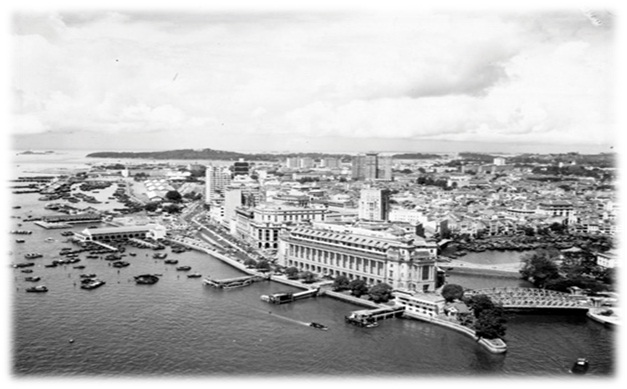

Republic of Singapore
After being expelled from Malaysia, Singapore became independent as the Republic of Singapore on 9 August 1965,with Lee Kuan Yew and Yusof bin Ishak as the first prime minister and president respectively. In 1967, the country co-founded the Association of Southeast Asian Nations (ASEAN). Race riots broke out once more in 1969. Lee Kuan Yew’s emphasis on rapid economic growth, support for business entrepreneurship, and limitations on internal democracy shaped Singapore’s policies for the next half-century. Economic growth continued throughout the 1980s, with the unemployment rate falling to 3% and real GDP growth averaging at about 8% up until 1999. During the 1980s, Singapore began to shift towards high-tech industries, such as the wafer fabrication sector, in order to remain competitive as neighbouring countries began manufacturing with cheaper labour. Singapore Changi Airport was opened in 1981 and Singapore Airlines was formed. The Port of Singapore became one of the world’s busiest ports and the service and tourism industries also grew immensely during this period.

Yusof bin Ishak (12 August 1910 – 23 November 1970) was a Singaporean politician who was the first president of Singapore, serving from 1965 to 1970.
Before becoming head-of-state, Yusof was a well-known journalist and co-founded Utusan Melayu. He started journalism after he graduated from Raffles Institution in 1929 and in 1932, he joined Warta Malaya, a well-known Malay newspaper company at that time. He left the company in 1938 and co-founded Utusan Melayu.
Yusof held many appointments within the Singaporean government. He served on the Film Appeal Committee from 1948 to 1950 and was also a member of both the Nature Reserves Committee and Malayanisation Commission for a year. In July 1959, he was appointed Chairman of the Public Service Commission, Singapore. He was sworn on 3 December that year as Singapore’s Yang di-Pertuan Negara (head of state) after the PAP won the first election held in Singapore after Singapore’s self-governance. Yusof then became the first president of Singapore after the country gained independence on 9 August 1965.
Yusof served for three terms in office before he died on 23 November 1970 due to heart failure. His portrait appears on the Singapore Portrait Series currency notes introduced in 1999.


Lee Kuan Yew (16 September 1923 – 23 March 2015), born Harry Lee Kuan Yew, often referred to by his initials LKY and in his earlier years as Harry Lee, was a Singaporean statesman and lawyer who served as the Prime Minister of Singapore between 1959 and 1990. He is widely recognised as the nation’s founding father.
Lee was born in Singapore during British colonial rule, which was then part of the Straits Settlements. He gained an educational scholarship to Raffles College, and during the Japanese occupation, he worked in private enterprises and as an administration service officer for the propaganda office. After the war, Lee attended the London School of Economics, but transferred to Fitzwilliam College, Cambridge, graduating with starred-first-class honours in law in 1947. He became a barrister of the Middle Temple in 1950 and campaigned for the United Kingdom to relinquish its colonial rule upon returning to Singapore.
Lee co-founded the People’s Action Party in 1954 and won his first seat in the Tanjong Pagar division in the 1955 election. He became the de facto opposition leader in the legislature to chief ministers David Marshall and Lim Yew Hock. Lee led his party to its first electoral victory in the 1959 election, and was appointed as the state’s first prime minister. To attain complete self-rule from Britain, Lee campaigned for a merger with other former British territories in a national referendum to form Malaysia in 1963. Racial strife and ideological differences led to Singapore’s separation from the federation to become a sovereign city-state in 1965.
With overwhelming parliamentary control at every election, Lee oversaw Singapore’s transformation into a developed country with a high-income economy within a single generation. In the process, he forged a highly effective, anti-corrupt government and civil service. Lee eschewed populist policies in favour of long-term social and economic planning, championing meritocracy and multiracialism as governing principles, making English the lingua franca to integrate its immigrant society and to facilitate trade with the world, whilst mandating bilingualism in schools to preserve students’ mother tongue and ethnic identity. Lee stepped down as prime minister in 1990, but remained in the Cabinet under his successors, holding the appointments of senior minister until 2004, then minister mentor until 2011. He died of pneumonia on 23 March 2015, aged 91. In a week of national mourning, about 1.7 million Singaporean residents and world leaders paid tribute to him at his lying-in-state at Parliament House and community tribute sites.



















Modern Singapore

Museums to know History of Singapore



